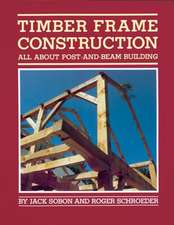Building the Timber Frame House: The Revival of a Forgotten Craft
Autor Tedd Benson Cu James Gruber Ilustrat de Jamie Pageen Limba Engleză Paperback – sep 1981
Preț: 89.09 lei
Preț vechi: 109.40 lei
-19% Nou
Puncte Express: 134
Preț estimativ în valută:
17.05€ • 17.80$ • 14.11£
17.05€ • 17.80$ • 14.11£
Carte disponibilă
Livrare economică 14-26 martie
Preluare comenzi: 021 569.72.76
Specificații
ISBN-13: 9780684172866
ISBN-10: 0684172860
Pagini: 224
Ilustrații: illustrations
Dimensiuni: 206 x 273 x 15 mm
Greutate: 0.5 kg
Ediția:FIRESIDE.
Editura: Touchstone Publishing
Colecția Touchstone
ISBN-10: 0684172860
Pagini: 224
Ilustrații: illustrations
Dimensiuni: 206 x 273 x 15 mm
Greutate: 0.5 kg
Ediția:FIRESIDE.
Editura: Touchstone Publishing
Colecția Touchstone
Notă biografică
Tedd Benson is the founder and owner of a post-and-beam construction firm in New Hampshire. A builder for ten years, he has specialized in timber framing for six.
Extras
CHAPTER ONE
WITH BROADAXE AND ADZE
A LOOK BACK
This carries us back to the time of the building of our old home, now more than fifty-five years ago; though only a lad we remember the time the trees were being felled in the forest and, after a long wait for the timbers to be squared, they were hauled to the building site, and, after a time for them to season, the carpenters came and, as though but yesterday, we see them under the old apple trees astride the timbers with auger, chisel and mallet working away from morn till night....Those were days of toil, days of contentment and peace.
Radford: Audels Carpenters and Builders Guide, 1923
According to Jacob Bronowski, a turning point for man began when he developed the capacity and summoned the will to cut and to split materials to form his structures. It was the difference between aggressively probing the structure of elements and passively submitting to their raw forms. In this difference was a seed of curiosity and adventure that burst, and with it, the mind of man expanded, for the growth of the intellect and the constructive work of the hands are the stalk and root of civilization. Before the Iron Age, homes were merely crude shelter; only slightly removed from other species, man was resigned to digging into the earth or fashioning huts with woven twigs and branches. He lived in burrows and nests, not homes. But when iron was finally wrested from stone and tools were formed, man was able to step out of his primitive past, out of the nests and pits, and into structures that would begin to reflect and to support his bold destiny.
The first sharpened tools were probably directed toward the shaping of a most fundamental building material -- wood. It was readily available, easily worked, and had already proven itself to be strong in earlier kinds of structures. So, timbers -- the building unit closest to the tree itself -- were the immediate choice for buildings that would now rise above the ground and start to show signs of permanence. What were built with those early tools and crudely shaped timbers were no longer just shelters but homes. They were now durable enough and functional enough to keep people settled in one area. This, in Kenneth Clark's definition, was the beginning of civilization. It was also the beginning of a building system so primal and basic that it would find its way into the development of many cultures in all parts of the world, yet so formidable and subtle that it would avoid mastery for many centuries.
If we mark the start of timber-frame construction with the fashioning of the first joints, it began around 200 B.C. Archaeological studies show that this development was simultaneous in the Far East and in Europe. And in both cases, the shapes of the first timber buildings had descended from earlier huts formed by lashing poles together over shallow pits. These huts had evolved into elongated rectangular structures with repeated central supports forming a series of bays. With a few modifications, this was a system perfectly suited to the joining of timbers, and it continues to be the fundamental design principle for timber-framed buildings today.
Right from the start, man showed an affinity to working with wood, to building with timbers. The individuality and the variety of wood maintained his curiosity; its humble acquiescence to his simple tools gave him satisfaction. Between the walls of these substantial buildings, there was security enough to release the caged and dormant portions of the mind. Therefore, greatly dependent on his construction methods, man sprinted into the future, falling many times in pursuit of an obscure goal. The development of timber framing, then, closely followed the rise and fall of numerous civilizations. There will not be an attempt here to encompass that history; it would fail and also miss the point of this book. Instead, we'll glance back and try to develop a feel for the full and sturdy past that forms the reference for our work with timbers today.
Though the origins of timber framing were early in the history of man, they were not necessarily primitive in form. Some of the greatly admired stone temples of Greece once stood as a similar network of carefully arranged and simply joined timbers. An historian in the second century A.D. wrote that Heraion at Olympia had one remaining wood column, the last of forty to be replaced with stone. When stone took the place of the wood that preceded it, the architecture necessarily became more massive, more monumental, in order to support the weight and reduce the spans of beams that were heavy and strong but not resilient. Because of their flexibility, wooden beams were able to make longer spans and columns didn't need to be so large. Perhaps this is why the vase painters of classical Greece depicted buildings much more airy and graceful than the stone structures that actually existed.
Farther east, in India, the same pattern was repeated -- stone buildings having been the monumental duplicates of their wooden predecessors. With the help of this relationship, archaeologists have dated Indian timber-frame construction to 200 B.C. Timbers were shaped from teak and connected with simple joinery and bamboo pegs. But there was nothing primitive about the richly ornate and highly refined buildings that are believed to have been built with these simple methods.
During this same period, the craft of joining timbers was beginning to flower in another Eastern country -- Japan. The Japanese, too, were putting their finest efforts toward the building of shrines and temples. But these were not destined to be replaced with stone. Japan has a history of being subjected to typhoons and earthquakes, and the builders quickly discovered that there were distinct advantages to the fibrous timbers and the hingelike joints that connected them. If a building constructed from stone or brick wiggles a bit, it will crack or break; if made of timbers, it only shrugs. So the Japanese carpenters dedicated themselves to finding the answers to the mysteries of working timbers. By the sixth century, with the help of immigrant Chinese Buddhists, their achievements in wooden structures were unrivaled. In 679 the Golden Hall was built, and in 693 the Pagoda. They both still stand, the oldest surviving wooden structures in the world.
If Japanese carpentry was highly evolved, it was also fiercely competitive. The craft was developed within a family guild system that maintained tight security over construction techniques and strict authority concerning procedure among its members. Intense rivalry between the two major guilds had the positive effect of keeping the standards high; a languid or sloppy attitude could not be tolerated in the heat of contest. But in the attempt to outdo one another, these guilds often produced joints much mote puzzling than they were effective. Still, they developed over four hundred joints, and many are still in use today. Japanese tradition has also given modern carpenters a special appreciation for their tools. The word that describes them, Dogu, translates to "the instruments of the way." Because Japanese carpenters are aware of all that has been accomplished with these instruments, they remain reluctant to relegate them to mere tools.
Closer to our own roots, in Europe, the evolution of timber framing was slower to mature, but when it came of age, it showed elements of sophistication and refinement previously unknown. As in Japan, there were well-organized and powerful guilds that maintained uniform high standards. But they were singular and without rivalry. Absent was the disparity from competition, and because of it there was unity and a bent toward the utilitarian. In that light, European craftsmen were able to discover the simple answers to seemingly complex problems. These were the people who built graceful roof trusses able to span sixty feet or more, entirely constructed of short timbers. And they were the ones who fashioned the vaulted ceilings so famous in,the magnificent cathedrals. They found ways to use angled braces not only for stability but also for ornament. When the upper class demanded extravagance, they received ornately carved embellishments in timbers joined in complex patterns, fit even for the most fastidious of lords.
But in timber framing's humble beginnings, there was no adornment; there was only a naturally curved tree, split lengthwise, with the halves inclined toward each other and joined at the peak. That was a "cruck" (see Glossary). When two or more of these crucks were connected, they formed a primitive frame. In a later refinement, a crossbeam was used to brace them and walls were built from the ends of the crossbeams to the base of the cruck. Finally, for lack of suitably bent trees, vertical posts were added and the cruck was reduced to simple rafters. Since it was no longer curved like a cruck (from crook), this new refinement was called a box frame. The simple elements of this box frame have been the basis for almost all the timber-framed structures that have followed.
The Norsemen, from northern Europe, were among those influenced by these developments. During the Viking era, they brought home some knowledge of the construction work being done by the English and French. When they combined this knowledge with their own ingenious shipbuilding skills, they were soon building lofty timber-framed sanctuaries -- monumental and difficult. In building these famous "stave churches," which numbered over seven hundred at one time, many construction problems were solved. From the twenty-five still standing, we can see how they rise in a tier effect, with a central roof surrounded by narrower, lean-to roof surfaces and topped with towers. The result is impressive.
To make the open frames livable buildings, carpenters and masons in other European countries and the British Isles commonly filled in between the timbers with bricks, plaster, or a plaster-and-stick composite called wattle and daub. This system would seem to offer almost no merit: the infilling was heavy, putting undue stresses on the frame; and brick and plaster have almost no insulation value. With every sigh or sag in a constantly shifting and breathing frame, there would be a new crack to fill; furthermore, the posts and beams of the structure itself were subjected daily to the ravages of the weather. Despite these shortcomings, the English Tudor buildings and the French manor houses, so constructed, are revered around the world as models of architectural elegance. And, truly, the white filling behind the dark frame produces clean lines and appealing contrast.
When the first European colonists set foot in the New World, they took a step backward in time. The wealth of virgin resources was spread resplendent before their eyes, but the fruitful rewards lay beyond the walls created by their lack of tools and skill and the bitter reality of a harsh New England winter. Immediate shelter was desperately needed; those who struggled through the ravages of the first few winters made their stand from crude pits covered with thatch and turf. Therefore, the history of timber framing in this country repeated the entire history of the craft from its Iron Age origins.
The experience of the first few winters was costly and cruel for many settlers, but through it they learned important lessons about the New World; more important, they learned to appreciate their own ability to adapt and experiment. In a sense, it helped them to sever their bonds with the Old World. Therefore, as timber framing developed in this country, those who practiced it naturally reached back to the mother countries for the age-old guidelines, but they took only what was needed and then moved in separate directions.
From humble origins, and with no kings or lords to please, the colonists first cleaned from the frames most of the embellishments, of which they had no need. Before they left England, they might have witnessed the impasse of the master joiners, who had so completely mastered the wooden joining methods that the only challenges that remained were those of adornment. In this, the joiners were in a frustrating and losing battle with those who molded plaster. The pragmatic American craftsmen turned from that and sought instead the subtle beauty of simple shapes and lines.
Although the first colonists came from England, others followed from France, Germany, Holland, and Scandinavia. With them they brought traditions, opinions, and information about building methods that were tossed into the melting pot and gently affected the state of the whole. Most of the timber framing done here could not be said to have originated from this or that country. It was a blend, and peculiarly American.
Mainly, American timber framing achieved its own form because North American conditions were so different from those in Europe. In the virgin forests of New England, trees of great length and breadth were commonplace. There was hardly a timber for any building that could not be hewn from a single tree; the need for the sophisticated joining methods to splice timbers lengthwise had almost been eliminated. Another factor was that the temperature variation in America was so great (110° F. average between high and low readings in Plymouth, Massachusetts, as opposed to 63° F. in Plymouth, England) that filling between the timbers with masonry produced very drafty results; sheathing skins had to be attached over the frames to protect both the timbers and the inhabitants.
The emerging new country enjoyed another special attribute that was a significant, if subtle, factor in the development of timber framing. There was a spirit of cooperation and neighborliness that would bring whole communities together for the purpose of helping one family raise their building. The timber-framing system was quickly modified so that large units could be preassembled, and the building could be easily erected in a day.
The spirit of community and goodwill was the ultimate variable. Massive frames could now be built by the average man for common purposes. Barns and houses sprouted in the towns and in the country; wherever men and women were willing to work toward dreams, there was vigor enough in the land, in the forests, and in the people to make them real.
Copyright © 1980 James Gruber and Tedd Benson
WITH BROADAXE AND ADZE
A LOOK BACK
This carries us back to the time of the building of our old home, now more than fifty-five years ago; though only a lad we remember the time the trees were being felled in the forest and, after a long wait for the timbers to be squared, they were hauled to the building site, and, after a time for them to season, the carpenters came and, as though but yesterday, we see them under the old apple trees astride the timbers with auger, chisel and mallet working away from morn till night....Those were days of toil, days of contentment and peace.
Radford: Audels Carpenters and Builders Guide, 1923
According to Jacob Bronowski, a turning point for man began when he developed the capacity and summoned the will to cut and to split materials to form his structures. It was the difference between aggressively probing the structure of elements and passively submitting to their raw forms. In this difference was a seed of curiosity and adventure that burst, and with it, the mind of man expanded, for the growth of the intellect and the constructive work of the hands are the stalk and root of civilization. Before the Iron Age, homes were merely crude shelter; only slightly removed from other species, man was resigned to digging into the earth or fashioning huts with woven twigs and branches. He lived in burrows and nests, not homes. But when iron was finally wrested from stone and tools were formed, man was able to step out of his primitive past, out of the nests and pits, and into structures that would begin to reflect and to support his bold destiny.
The first sharpened tools were probably directed toward the shaping of a most fundamental building material -- wood. It was readily available, easily worked, and had already proven itself to be strong in earlier kinds of structures. So, timbers -- the building unit closest to the tree itself -- were the immediate choice for buildings that would now rise above the ground and start to show signs of permanence. What were built with those early tools and crudely shaped timbers were no longer just shelters but homes. They were now durable enough and functional enough to keep people settled in one area. This, in Kenneth Clark's definition, was the beginning of civilization. It was also the beginning of a building system so primal and basic that it would find its way into the development of many cultures in all parts of the world, yet so formidable and subtle that it would avoid mastery for many centuries.
If we mark the start of timber-frame construction with the fashioning of the first joints, it began around 200 B.C. Archaeological studies show that this development was simultaneous in the Far East and in Europe. And in both cases, the shapes of the first timber buildings had descended from earlier huts formed by lashing poles together over shallow pits. These huts had evolved into elongated rectangular structures with repeated central supports forming a series of bays. With a few modifications, this was a system perfectly suited to the joining of timbers, and it continues to be the fundamental design principle for timber-framed buildings today.
Right from the start, man showed an affinity to working with wood, to building with timbers. The individuality and the variety of wood maintained his curiosity; its humble acquiescence to his simple tools gave him satisfaction. Between the walls of these substantial buildings, there was security enough to release the caged and dormant portions of the mind. Therefore, greatly dependent on his construction methods, man sprinted into the future, falling many times in pursuit of an obscure goal. The development of timber framing, then, closely followed the rise and fall of numerous civilizations. There will not be an attempt here to encompass that history; it would fail and also miss the point of this book. Instead, we'll glance back and try to develop a feel for the full and sturdy past that forms the reference for our work with timbers today.
Though the origins of timber framing were early in the history of man, they were not necessarily primitive in form. Some of the greatly admired stone temples of Greece once stood as a similar network of carefully arranged and simply joined timbers. An historian in the second century A.D. wrote that Heraion at Olympia had one remaining wood column, the last of forty to be replaced with stone. When stone took the place of the wood that preceded it, the architecture necessarily became more massive, more monumental, in order to support the weight and reduce the spans of beams that were heavy and strong but not resilient. Because of their flexibility, wooden beams were able to make longer spans and columns didn't need to be so large. Perhaps this is why the vase painters of classical Greece depicted buildings much more airy and graceful than the stone structures that actually existed.
Farther east, in India, the same pattern was repeated -- stone buildings having been the monumental duplicates of their wooden predecessors. With the help of this relationship, archaeologists have dated Indian timber-frame construction to 200 B.C. Timbers were shaped from teak and connected with simple joinery and bamboo pegs. But there was nothing primitive about the richly ornate and highly refined buildings that are believed to have been built with these simple methods.
During this same period, the craft of joining timbers was beginning to flower in another Eastern country -- Japan. The Japanese, too, were putting their finest efforts toward the building of shrines and temples. But these were not destined to be replaced with stone. Japan has a history of being subjected to typhoons and earthquakes, and the builders quickly discovered that there were distinct advantages to the fibrous timbers and the hingelike joints that connected them. If a building constructed from stone or brick wiggles a bit, it will crack or break; if made of timbers, it only shrugs. So the Japanese carpenters dedicated themselves to finding the answers to the mysteries of working timbers. By the sixth century, with the help of immigrant Chinese Buddhists, their achievements in wooden structures were unrivaled. In 679 the Golden Hall was built, and in 693 the Pagoda. They both still stand, the oldest surviving wooden structures in the world.
If Japanese carpentry was highly evolved, it was also fiercely competitive. The craft was developed within a family guild system that maintained tight security over construction techniques and strict authority concerning procedure among its members. Intense rivalry between the two major guilds had the positive effect of keeping the standards high; a languid or sloppy attitude could not be tolerated in the heat of contest. But in the attempt to outdo one another, these guilds often produced joints much mote puzzling than they were effective. Still, they developed over four hundred joints, and many are still in use today. Japanese tradition has also given modern carpenters a special appreciation for their tools. The word that describes them, Dogu, translates to "the instruments of the way." Because Japanese carpenters are aware of all that has been accomplished with these instruments, they remain reluctant to relegate them to mere tools.
Closer to our own roots, in Europe, the evolution of timber framing was slower to mature, but when it came of age, it showed elements of sophistication and refinement previously unknown. As in Japan, there were well-organized and powerful guilds that maintained uniform high standards. But they were singular and without rivalry. Absent was the disparity from competition, and because of it there was unity and a bent toward the utilitarian. In that light, European craftsmen were able to discover the simple answers to seemingly complex problems. These were the people who built graceful roof trusses able to span sixty feet or more, entirely constructed of short timbers. And they were the ones who fashioned the vaulted ceilings so famous in,the magnificent cathedrals. They found ways to use angled braces not only for stability but also for ornament. When the upper class demanded extravagance, they received ornately carved embellishments in timbers joined in complex patterns, fit even for the most fastidious of lords.
But in timber framing's humble beginnings, there was no adornment; there was only a naturally curved tree, split lengthwise, with the halves inclined toward each other and joined at the peak. That was a "cruck" (see Glossary). When two or more of these crucks were connected, they formed a primitive frame. In a later refinement, a crossbeam was used to brace them and walls were built from the ends of the crossbeams to the base of the cruck. Finally, for lack of suitably bent trees, vertical posts were added and the cruck was reduced to simple rafters. Since it was no longer curved like a cruck (from crook), this new refinement was called a box frame. The simple elements of this box frame have been the basis for almost all the timber-framed structures that have followed.
The Norsemen, from northern Europe, were among those influenced by these developments. During the Viking era, they brought home some knowledge of the construction work being done by the English and French. When they combined this knowledge with their own ingenious shipbuilding skills, they were soon building lofty timber-framed sanctuaries -- monumental and difficult. In building these famous "stave churches," which numbered over seven hundred at one time, many construction problems were solved. From the twenty-five still standing, we can see how they rise in a tier effect, with a central roof surrounded by narrower, lean-to roof surfaces and topped with towers. The result is impressive.
To make the open frames livable buildings, carpenters and masons in other European countries and the British Isles commonly filled in between the timbers with bricks, plaster, or a plaster-and-stick composite called wattle and daub. This system would seem to offer almost no merit: the infilling was heavy, putting undue stresses on the frame; and brick and plaster have almost no insulation value. With every sigh or sag in a constantly shifting and breathing frame, there would be a new crack to fill; furthermore, the posts and beams of the structure itself were subjected daily to the ravages of the weather. Despite these shortcomings, the English Tudor buildings and the French manor houses, so constructed, are revered around the world as models of architectural elegance. And, truly, the white filling behind the dark frame produces clean lines and appealing contrast.
When the first European colonists set foot in the New World, they took a step backward in time. The wealth of virgin resources was spread resplendent before their eyes, but the fruitful rewards lay beyond the walls created by their lack of tools and skill and the bitter reality of a harsh New England winter. Immediate shelter was desperately needed; those who struggled through the ravages of the first few winters made their stand from crude pits covered with thatch and turf. Therefore, the history of timber framing in this country repeated the entire history of the craft from its Iron Age origins.
The experience of the first few winters was costly and cruel for many settlers, but through it they learned important lessons about the New World; more important, they learned to appreciate their own ability to adapt and experiment. In a sense, it helped them to sever their bonds with the Old World. Therefore, as timber framing developed in this country, those who practiced it naturally reached back to the mother countries for the age-old guidelines, but they took only what was needed and then moved in separate directions.
From humble origins, and with no kings or lords to please, the colonists first cleaned from the frames most of the embellishments, of which they had no need. Before they left England, they might have witnessed the impasse of the master joiners, who had so completely mastered the wooden joining methods that the only challenges that remained were those of adornment. In this, the joiners were in a frustrating and losing battle with those who molded plaster. The pragmatic American craftsmen turned from that and sought instead the subtle beauty of simple shapes and lines.
Although the first colonists came from England, others followed from France, Germany, Holland, and Scandinavia. With them they brought traditions, opinions, and information about building methods that were tossed into the melting pot and gently affected the state of the whole. Most of the timber framing done here could not be said to have originated from this or that country. It was a blend, and peculiarly American.
Mainly, American timber framing achieved its own form because North American conditions were so different from those in Europe. In the virgin forests of New England, trees of great length and breadth were commonplace. There was hardly a timber for any building that could not be hewn from a single tree; the need for the sophisticated joining methods to splice timbers lengthwise had almost been eliminated. Another factor was that the temperature variation in America was so great (110° F. average between high and low readings in Plymouth, Massachusetts, as opposed to 63° F. in Plymouth, England) that filling between the timbers with masonry produced very drafty results; sheathing skins had to be attached over the frames to protect both the timbers and the inhabitants.
The emerging new country enjoyed another special attribute that was a significant, if subtle, factor in the development of timber framing. There was a spirit of cooperation and neighborliness that would bring whole communities together for the purpose of helping one family raise their building. The timber-framing system was quickly modified so that large units could be preassembled, and the building could be easily erected in a day.
The spirit of community and goodwill was the ultimate variable. Massive frames could now be built by the average man for common purposes. Barns and houses sprouted in the towns and in the country; wherever men and women were willing to work toward dreams, there was vigor enough in the land, in the forests, and in the people to make them real.
Copyright © 1980 James Gruber and Tedd Benson
Cuprins
CONTENTS
PREFACE
PART I. THE PAST
Chapter One. WITH BROADAXE AND ADZE: A Look Back
PART II. THE PRESENT
Chapter Two. STRUCTURES FOR TODAY: Timbers and Frames
Chapter Three. THE JOINER'S VISION: Description and Layout
Chapter Four. THE JOINER'S WORK: Removing Wood
Chapter Five. PUTTING IT ALL TOGETHER: Assembly and Raising
PART III. DESIGN THOUGHTS
Chapter Six. BUILDING FOR STRENGTH: A Structural Look
Chapter Seven. BUILDING FOR TODAY: Design Considerations
APPENDICES
1. Beam-Design Formulas
2. Designing Beams by Using Formulas
3. Beam Design Tables
Glossary
References
List of Plates
Recenzii
Boston Globe If you've been in an old barn and marveled at the great beams and posts, then you know what a timber frame is....Building the Timber Frame House...is a brilliant book on two levels, as a history and philosophical raison d'etre of timber-frame construction...and [as] a no-nonsense, how-to guide.
Building and Remodeling Instructions are so complete that if you have (or can command) basic carpentry skills, this could be your sole house-building source.
Popular Science A delightful handbook.
Building and Remodeling Instructions are so complete that if you have (or can command) basic carpentry skills, this could be your sole house-building source.
Popular Science A delightful handbook.
Descriere
Synopsis coming soon.......














